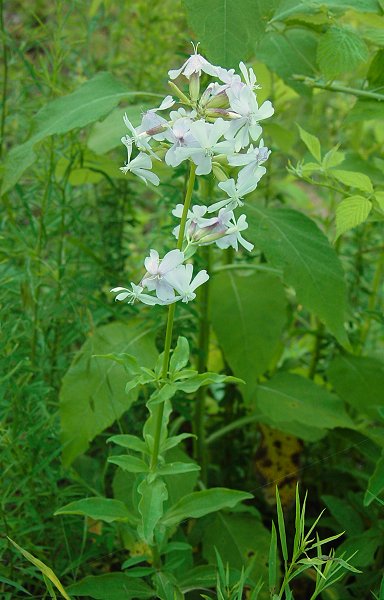Saponaria officinalis L.
Bouncing-Bet, Soapwort

Introduced
CC = *
CW = 3
MOC = 64
© DETenaglia
Saponaria officinalis L.Bouncing-Bet, Soapwort | |
 |
Introduced CC = * CW = 3 MOC = 64 |
© DETenaglia |
|
Family - Caryophyllaceae Habit - Perennial forb, colonial from long-creeping, branched rhizomes. Stems - Ascending to erect, to 90 cm, occasionally from a spreading base, single or multiple, unbranched or branched, glabrous.
Leaves - Opposite, simple, fused basally into a sheath, sessile or with a poorly differentiated, winged petiole to 1.5 cm long, lacking axillary clusters of leaves. Stipules absent. Leaf blades 3-11 cm long, elliptic to ovate or oblanceolate, not fleshy, tapered at the base, rounded or angled to a bluntly or sharply pointed tip, entire, slightly wavy to crisped on margins, with 3 main veins. Inflorescences - Dense terminal clusters (those on short lateral branches sometimes appearing axillary). Flower stalks 0.1-0.5 cm long, erect to spreading at flowering and fruiting, glabrous, the bracts paired and resembling small leaves.
Flowers - Sepals 5, 15-20 mm long, becoming elongated to 25 mm long at fruiting, fused basally into a slender tube, this 15-25-nerved, herbaceous and green or reddish-tinged between the sepals, the lobes narrowly triangular, shorter than the tube, angled or tapered to a sharply pointed tip, the margins papery and white. Petals 5, showy, 23-35 mm long, oblanceolate to spatulate, tapered to a stalklike base and this more or less fused to the ovary stalk, the expanded portion 0.8-1.5 cm long, rounded to shallowly notched at the tip, pink to white, with a pair of small appendages on the upper surface at the base of the expanded, spreading apical portion. Stamens 10, the filaments fused at the base. Staminodes absent. Pistil with 1 locule, the ovary with a stalk 2-5 mm long. Styles 2, distinct, each with a stigmatic area along the inner surface.
Fruits - Capsules 15-20 mm long, opening by 4 ascending to recurved teeth. Seeds mostly 30-75, 1.6-2.0 mm wide, kidney-shaped, the surface with minute, broad papillae or appearing pebbled, dark brown, lacking wings or appendages. Flowering - June - October. Habitat - Streambanks, fields, pastures, fencerows, old homesites, gardens, railroads, roadsides, open disturbed areas. Also cultivated. Origin - Native to Europe. Lookalikes - Broadly, some species of Silene, such as S. latifolia. Other info. - This species can be found throughout Missouri, though less commonly in the northwestern third of the state. It is also found, to a greater or lesser extent, in every state in the continental U.S. It has been grown as an ornamental but has escaped and is well established in much of North America. The flowers resemble those of some species of Silene but have only two styles, as opposed to the 3-5 present in Silene pistillate flowers. Photographs taken at Dave Rock Conservation Area, St. Clair County, MO., 7-12-00, and in Van Buren, MO., 6-16-01 (DETenaglia); also at LaBarque Creek Conservation Area, Jefferson County, MO, 6-21-2011, Little Lost Creek Conservation Area, Warren County, MO, 7-10-2012, and near Hog Canyon, Uintah County, UT, 6-27-2018, (SRTurner). |